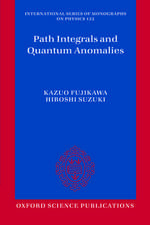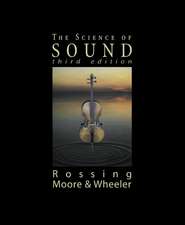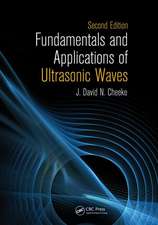Phononic Crystals: Artificial Crystals for Sonic, Acoustic, and Elastic Waves: De Gruyter Studies in Mathematical Physics, cartea 26
Autor Vincent Laudeen Limba Engleză Hardback – 27 aug 2015
| Toate formatele și edițiile | Preț | Express |
|---|---|---|
| Hardback (2) | 1383.08 lei 6-8 săpt. | |
| De Gruyter – 14 aug 2024 | 1383.08 lei 6-8 săpt. | |
| De Gruyter – 27 aug 2015 | 1543.67 lei 6-8 săpt. |
Din seria De Gruyter Studies in Mathematical Physics
- 9%
 Preț: 1038.23 lei
Preț: 1038.23 lei -
 Preț: 247.77 lei
Preț: 247.77 lei - 23%
 Preț: 984.75 lei
Preț: 984.75 lei - 23%
 Preț: 1151.92 lei
Preț: 1151.92 lei - 23%
 Preț: 1645.11 lei
Preț: 1645.11 lei - 23%
 Preț: 1545.00 lei
Preț: 1545.00 lei - 23%
 Preț: 975.30 lei
Preț: 975.30 lei - 23%
 Preț: 1646.44 lei
Preț: 1646.44 lei - 23%
 Preț: 1867.38 lei
Preț: 1867.38 lei - 23%
 Preț: 1537.16 lei
Preț: 1537.16 lei - 23%
 Preț: 1543.37 lei
Preț: 1543.37 lei - 9%
 Preț: 983.47 lei
Preț: 983.47 lei - 23%
 Preț: 1646.58 lei
Preț: 1646.58 lei - 23%
 Preț: 1533.02 lei
Preț: 1533.02 lei - 23%
 Preț: 1800.80 lei
Preț: 1800.80 lei - 23%
 Preț: 1153.85 lei
Preț: 1153.85 lei - 23%
 Preț: 1910.97 lei
Preț: 1910.97 lei - 23%
 Preț: 877.28 lei
Preț: 877.28 lei - 23%
 Preț: 1371.97 lei
Preț: 1371.97 lei - 23%
 Preț: 1368.28 lei
Preț: 1368.28 lei - 23%
 Preț: 1434.84 lei
Preț: 1434.84 lei - 23%
 Preț: 1542.79 lei
Preț: 1542.79 lei - 23%
 Preț: 1535.66 lei
Preț: 1535.66 lei - 23%
 Preț: 1651.79 lei
Preț: 1651.79 lei - 23%
 Preț: 1435.42 lei
Preț: 1435.42 lei - 23%
 Preț: 1436.76 lei
Preț: 1436.76 lei - 27%
 Preț: 912.78 lei
Preț: 912.78 lei - 27%
 Preț: 1009.60 lei
Preț: 1009.60 lei - 27%
 Preț: 916.08 lei
Preț: 916.08 lei - 27%
 Preț: 916.08 lei
Preț: 916.08 lei - 27%
 Preț: 715.70 lei
Preț: 715.70 lei - 27%
 Preț: 773.24 lei
Preț: 773.24 lei - 27%
 Preț: 916.08 lei
Preț: 916.08 lei
Preț: 1543.67 lei
Preț vechi: 2004.77 lei
-23% Nou
295.42€ • 307.28$ • 243.88£
Carte tipărită la comandă
Livrare economică 15-29 aprilie
Specificații
ISBN-10: 3110302659
Pagini: 419
Ilustrații: 13 schw.-w. Abb., 200 schw.-w. Zeichn.
Dimensiuni: 170 x 240 mm
Greutate: 0.87 kg
Editura: De Gruyter
Colecția De Gruyter
Seria De Gruyter Studies in Mathematical Physics
Locul publicării:Berlin/Boston
Notă biografică
Cuprins
1 Introduction [6 p.] Description and purpose of the book. Introduction of some elementary concepts. History of the phononic crystal concept. 2 Waves in periodic media [40 p.] A presentation of waves in periodic media devoid of complications like polarization, anisotropy, tensors, loss, etc. Self-contained presentation for scalar waves. 2.1 Bloch theorem Scalar wave theory. Scalar Helmholtz equation. Bloch theorem. 2.2 Physical origin of band gaps 1D periodic media. Scattering and diffraction. Bragg band gaps. Local and Fano resonances. 2.3 Brillouin zone Definition. Direct and reciprocal lattice. 2.4 The band structure Fourier transforms. Wave vectors. Band structure. Dispersion, group velocity. Equifrequency contours. Analogy with phonons in atomic lattices. 2.5 Appendix: Brillouin zones for 2D and 3D lattices Geometrical description of the most common lattices. 3 Acoustic waves [20 p.] A synthetic presentation of the subject, with reference to other basic books. 3.1 Dynamic equations Particle velocity and pressure. Acoustic equations. 3.2 Constants of fluids Constants for fluids. Determination of bulk velocities. 3.3 Loss and viscosity Representation of propagation loss in fluids. Modifications of equations (complex material constants). 3.4 Reflection and refraction Brief review of reflection and refraction at the interface of 2 media. Fresnel formulas. 4 Sonic crystals [50 p.] Introduce sonic crystals (that can be described by pressure waves), with accent on finite element modeling and basic properties.4.1 Modeling of sonic crystals 4.1.1 Analysis via plane wave expansion (PWE) 4.1.2 Multiple scattering theory (MST and LMS) 4.1.3 Finite element modeling (FEM) 4.2 2D sonic crystal Steel cylinders in air. Steel cylinders in water. Measurement techniques. Comparison with experiment. Deaf bands. 4.3 3D sonic crystals Steel beads in water. 4.4 Tutorial: sonic crystal analysis with FEM Generation of band structures. Plotting Bloch waves. Worked examples with ff++. 4.5 Appendix: Weak form modeling of sonic crystals. Lagrange Finite elements. Bloch waves and FEM. 5 Elastic waves [40 p.] A synthetic presentation of the subject, with reference to other basic books, plus an original part on FEM modeling. 5.1 Dynamic equations Strain and Stress. Elastic constants. Elastodynamic equations. 5.2 Christoffel equation for bulk waves Anisotropy of wave propagation in crystalline solids. Slowness curve. Wave surface. Polarization. Group velocity. Poynting theorem and energy conservation. 5.3 Piezoelectric media Description of the effect. Generalization of the concepts of the previous section. 5.4 Plate waves Lamb and other plate waves. Dispersion diagram. 5.5 Surface waves Rayleigh and other surface waves. Radiation and leakage. Slowness curves for SAW. 5.6 Tutorial: modeling plate waves with FEM 5.7 Appendix: tensors 6 Phononic crystals for bulk waves [50 p.] 6.1 Modeling of phononic crystals 6.1.1 Analysis via plane wave expansion (PWE) 6.1.2 Finite element modeling (FEM) 6.2 2D phononic crystal Holey and solid-solid PC, for most common material combinations. Comparison with experiments. 6.3 3D phononic crystals Steel beads in epoxy. Comparison with experiments. 6.4 Tutorial: phononic crystal analysis with FEM Generation of band structures. Plotting Bloch waves. Worked examples with ff++.6.5 Appendix: weak form modeling of phononic crystals 7 Phononic crystals for surface and plate waves [40 p.] 7.1 Modeling Presentation based on PWE and/or FEM. Surface boundary conditions and determinants. 7.2 Phononic plates Specific properties and discussion of various forms. Preferred example: holey silicon plate. 7.3 Surface phononic crystals Specific properties and discussion of various forms. Preferred examples: holey silicon and lithium niobate. The sound cone and leakage. 7.4 Measurement methods Electrical transduction. Optical transduction. Optical measurement of surface displacements. Comparison with experiments. 7.5 Tutorial: phononic plates and surface waves with FEM 8 Coupling of acoustic and elastic waves in phononic crystals [20 p.] 8.1 Phononic crystal of solid inclusions in fluid 8.2 Phononic plates in water and air 8.3 Corrugated surfaces and plates Scholte-Stoneley wave. Conversion of bulk to surface waves. 9 Evanescent Bloch waves [30 p.] 9.1 Theory P.E and FEM 9.2 Sonic crystals Complex band structure. Symmetry and deaf bands. 9.3 Phononic crystals Complex band structure. Polarization evolution across phononic band gap. 9.4 Super-cells and defect mode Discussion of wave confinement in relation with evanescence. 10 Locally-resonant crystals [30 p.] 10.1 Local resonance, Fano resonance, metamaterials Discussion of the difference between Bragg band gaps and locally-resonant band gaps. 10.2 1D corrugated waveguides Resonances introduced by resonators grafted along a waveguide.















